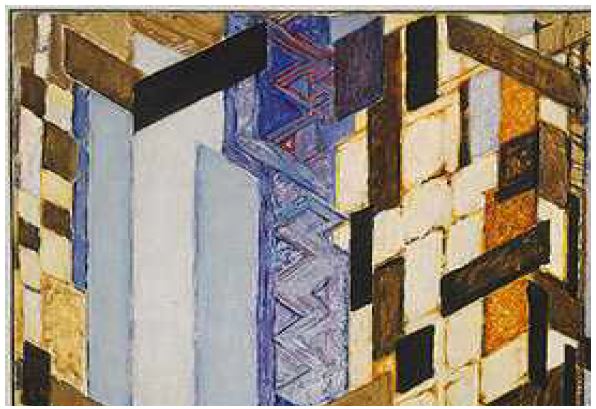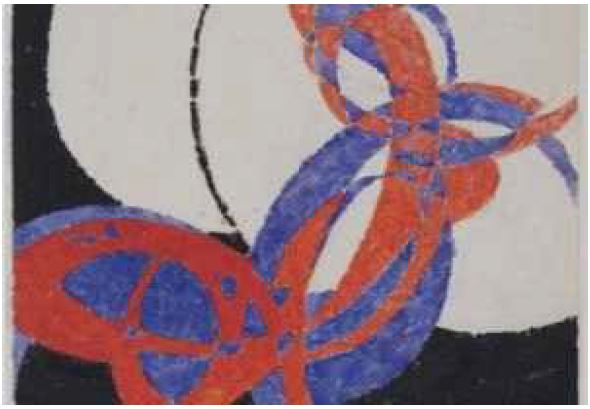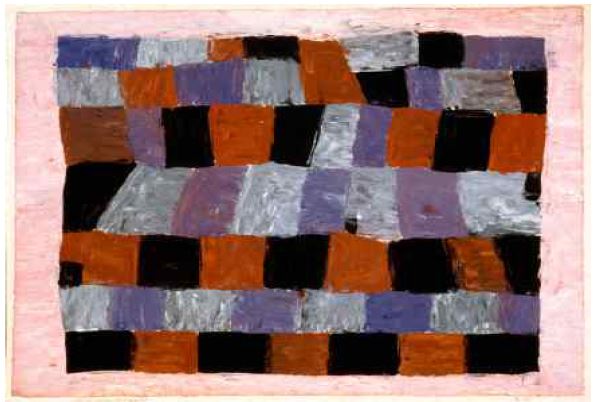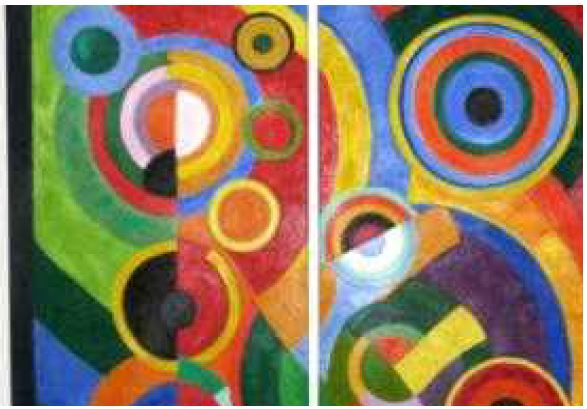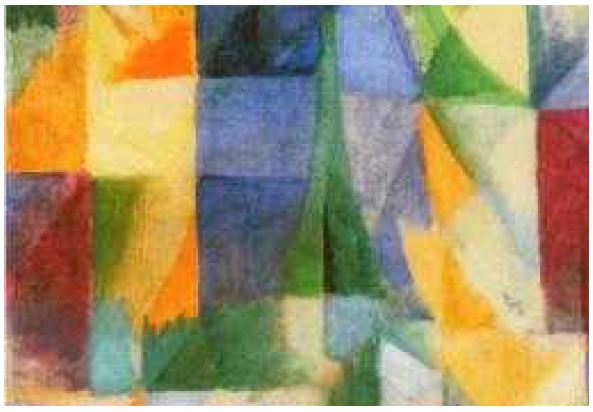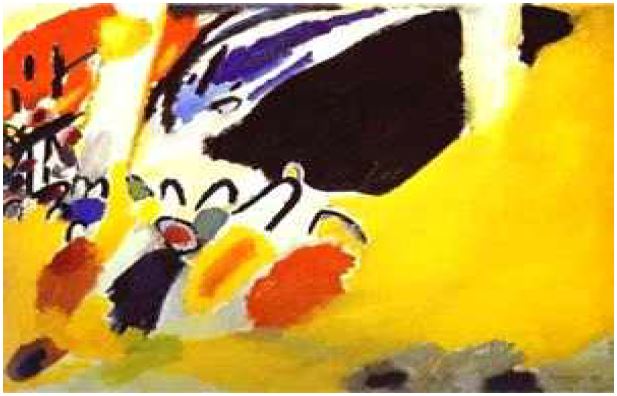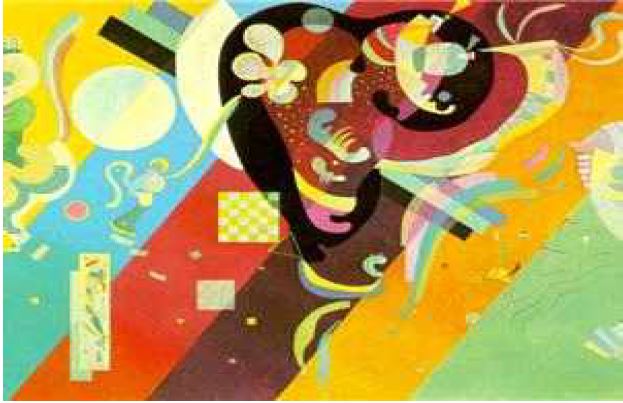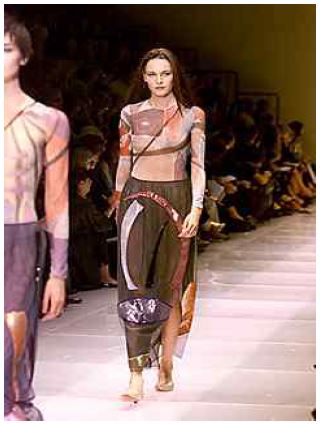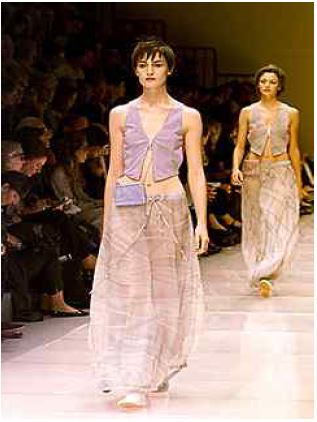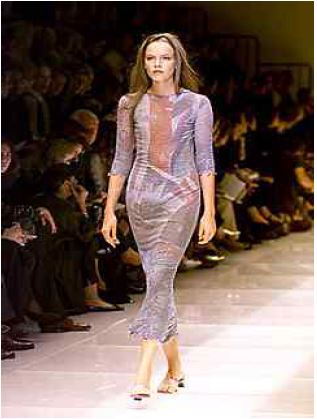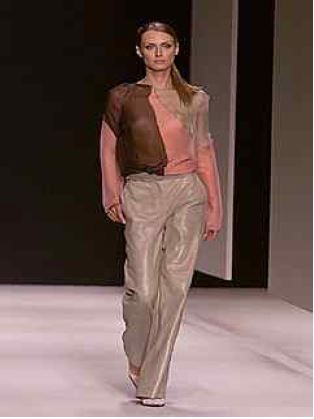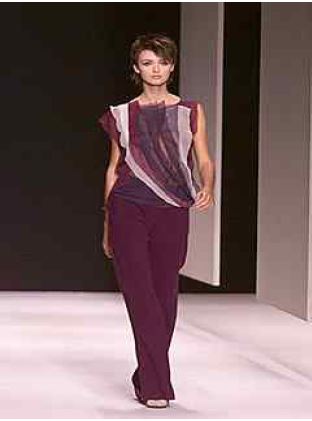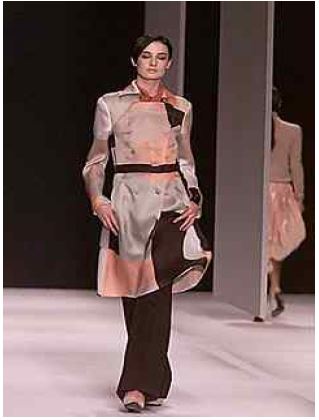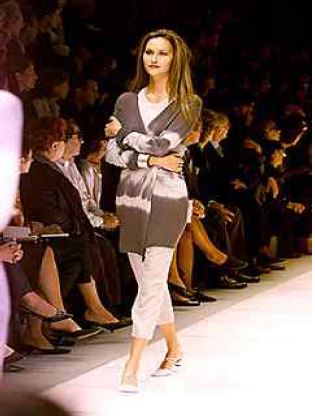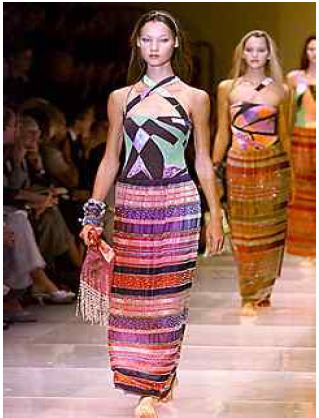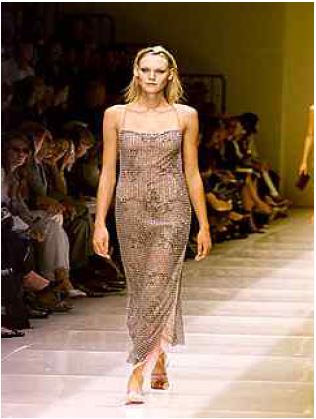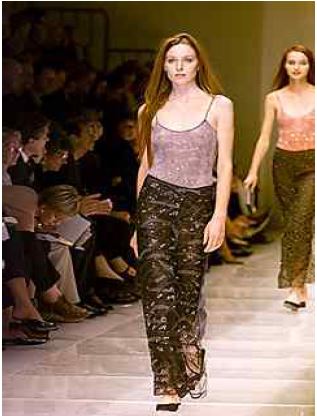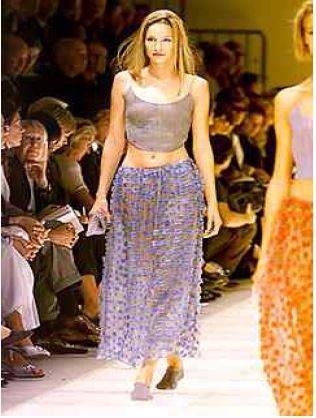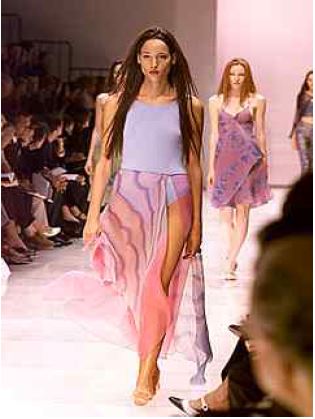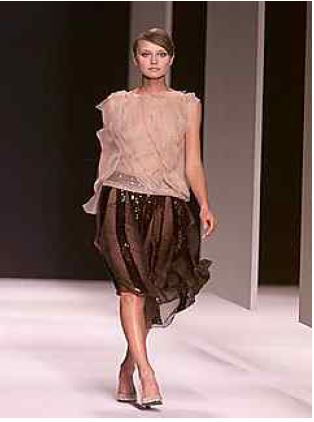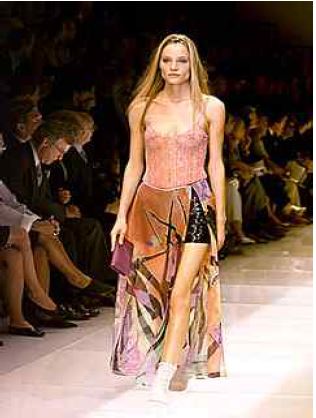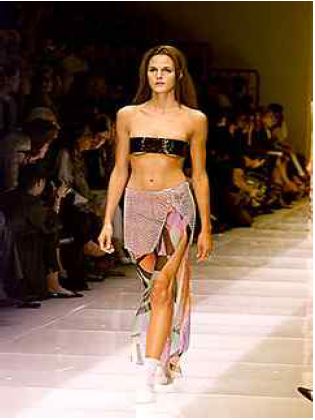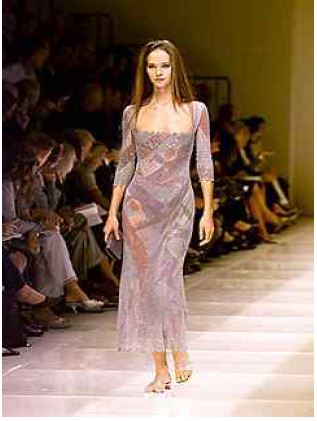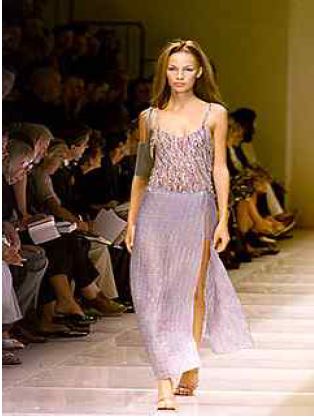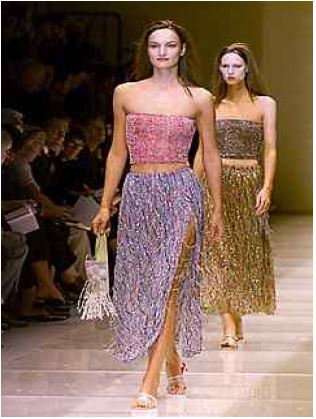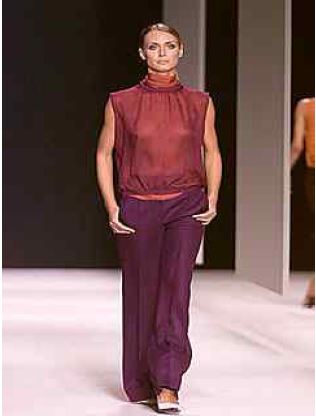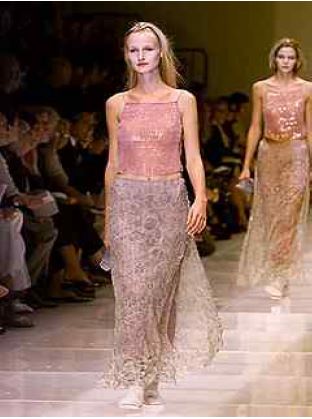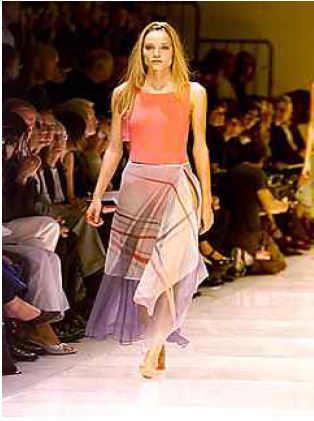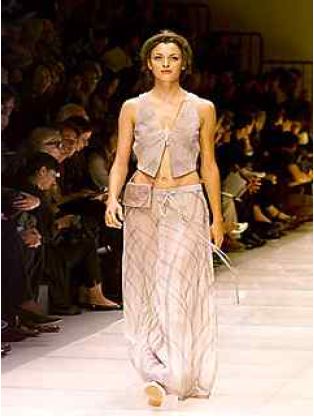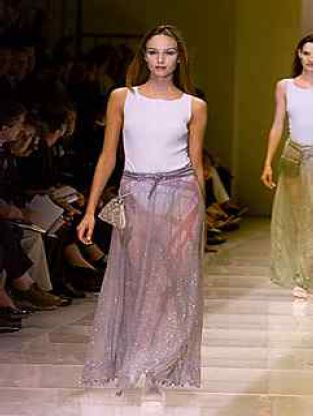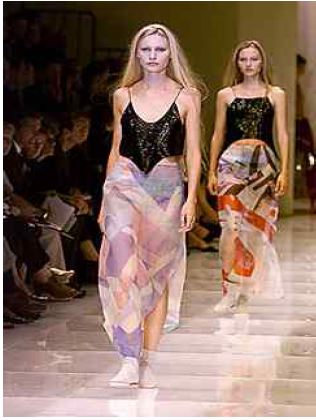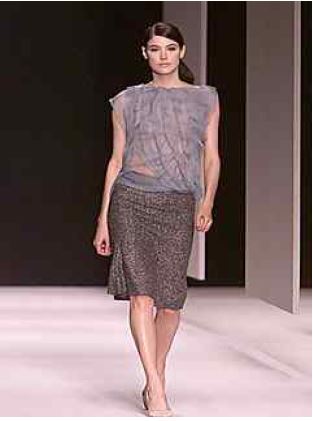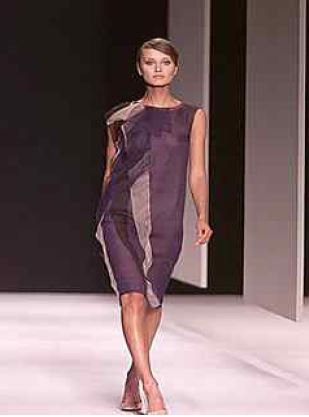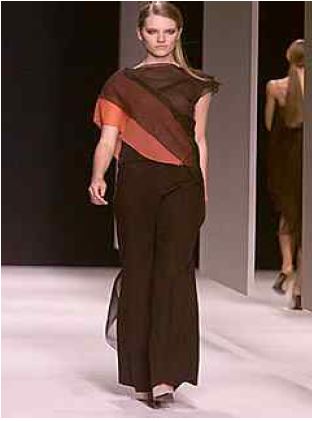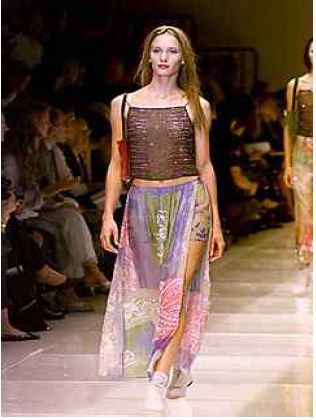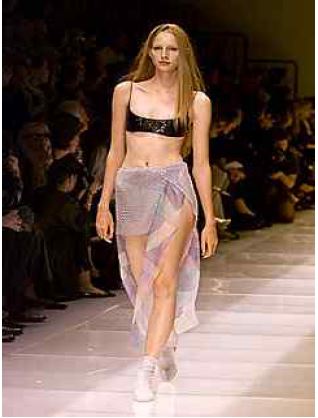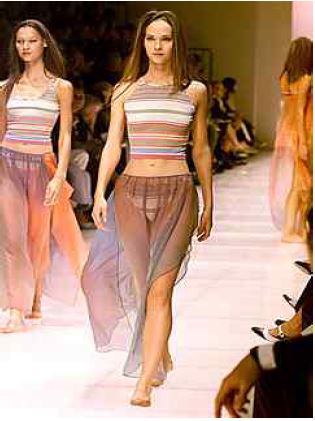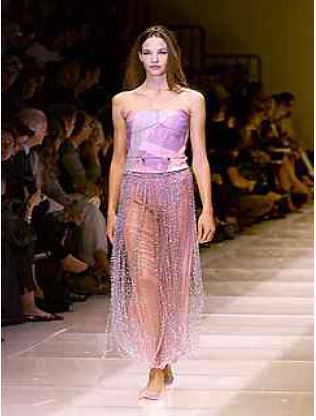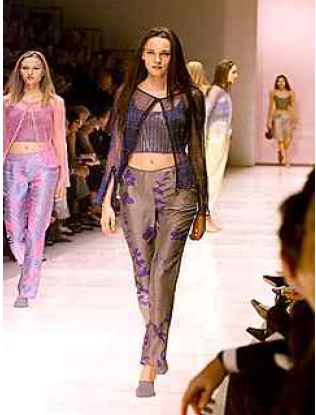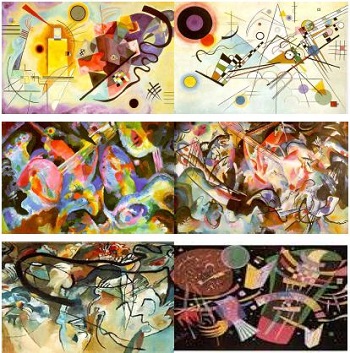
Fashion Design Expression of Wassily Kandinsky's Paintings : Focus on Music Visualization
Abstract
This study examines music visualization characteristics appearing in Giorgio Armani's S/S 2000 Collection and Genny's F/W 2000 Collection, which elicited and reinterpreted the characteristics through an analysis of Kandinsky's paintings. Study results are as follows. First, music visualization characteristics were extracted through an analysis of Kandinsky's works to examine music visualization that appears in contemporary fashion. Further analysis of Kandinsky’s works were done in regards to music visualization (Impression, Improvisation, and Composition), and music visualization characteristics were categorized into ‘spatial element’, ‘mobility’, and ‘overlap’. Second, the analysis of contemporary fashion with a spatial component showed that space was often clothed through color contrasts that highlighted concise and playful effects. Emphasis on line and three-dimensional effects were shown by overlapping lines and costume pleats with exposure expressed by semiotic forms and fabric character4istics. Third, the analysis of clothes that express mobility shows that they commonly express mobility through free color arrangements and a shading of colors with playfulness. The effects of emphasis, uniformity, and exposure were shown through the gloss and transformation of fabric that emphasized fabric characteristics; in addition, the effect of simplicity, three-dimensionality, and uniformity were expressed by adopting the forms of geometric shapes. Fourth, the analysis of clothes that manifest the overlap showed a predominant overlapping of colors and fabric. The esthetic effects of playfulness and exposure were emphasized through colors, shapes, and lines.
Keywords:
music visualization, wassily kandinsky, modern fashion, aesthetic effectⅠ. Introduction
The value of the fashion and clothing industry in the 21st century is winning cultural and artistic recognition in addition to a primary function to satisfy human needs. Clothing was first categorized as a tactile product that protects the body from nature; subsequently, a visual function was reinforced to show a symbolic identification of social status. Clothing continues to distinguish social class and express individuality.
The 21st century fashion industry is not restricted to the clothing industry and has an established value as a culture and art industry. The fashion industry needs an additional role that is emotionally satisfying with synesthetic phenomena as it grows into a sensible industry that stimulates innate human emotions found in the culture and art industry.
This study has significance in examining methods that satisfy the feelings of mass appeal through the study of music visualization characteristics manifested in fashion design. Studies on synesthetic phenomena in fashion design deal with music visualization that are a visual stimulation phenomena of fashion designs that suggest the auditory stimulation of music. Jung(2002) and Lee(2008) previously analyzed musical characteristics of a music genre and developed a costume design based on images projected in music. Nam(2005) applied visualized music images to costume designs that centered on music rhythms; in addition, Kim(2012) analyzed each popular music genre and their potential application to textile pattern development. The preceding studies analyzed music visualization characteristics to extract various images, sort various images, and apply various images to costume design. Lee(2003) stated that music is auditory art that can be sensed as color and form through synaesthesia. Applying music images by synesthesia represents an approach to human sensibility because a costume conveys the human body image and meaning through shape and color.
Previous studies have applied music visualization to costume design. However, there is a need to design image objectivity to produce clothes that can conceptualize music visualization. This study analyzes contemporary fashion design based on music visualization characteristics manifested through works by Wassily Kandinsky who was one of the representative painters of the 19th and 20th century abstract art.
Approaching music visualization through Kandinsky’s paintings and philosophy increases the objectivity of this study. This study provides basic data to apply music visualization to fashion design. First, it examines the definition and concept of music visualization through previous studies and literature. Second, it analyzes music visualization characteristics manifested in Kandinsky's paintings and theories based on a theoretical examination of the definition and concept of music visualization. Third, it analyzes music visualization characteristics manifested in selected contemporary fashion designers' works that utilized Kandinsky's paintings. This study chose the following subjects to establish a fashion design direction through music visualization. First, it analyzed music visualization characteristics that center on Kandinsky's paintings to understand the potential to combine music visualization with fashion design. Second, it analyzed design techniques that express music visualization and music visualization characteristics in the designs and fashion designers’ works that utilized themes from Kandinsky's paintings.
This study selected contemporary fashion that utilized music visualization found in Kandinsky’s paintings. Research was limited to the collections of fashion designers who utilized ideas from Kandinsky's paintings to secure a correlation between study subjects when analyzing music visualization characteristics in fashion. An objective segmentation examined only collections influenced by the elements of Kandinsky's works that have been reviewed by overseas fashion magazine editors. We selected collections from overseas fashion magazine editors inspired by Kandinsky’s works for an objective study subject selection. Research included Giorgio Armani's Spring Ready-to-Wear Collection of 2000, that America's Style editor Armand Limnander argued were inspired by the lines and colors of Kandinsky to suggest a beacon for the new millennium and the feminine silhouette. Also included were Genny's Fall Ready-to-Wear Collection of 2000 as inspired by the works of Kandinsky with exploding purple, light and thin green, orange, magenta, and peach.
This study intends to establish a perception of music visualization based on theoretical music visualization concepts. We investigated music visualization characteristics promoted by Kandinsky and studied cases of contemporary fashion design that utilized Kandinsky's paintings. We conducted theoretical and empirical studies for an analysis that categorized music visualization manifest in contemporary fashion design and based on Kandinsky's theories. The theoretical studies examined previous studies that combined music visualization with costumes and philosophy that focused on Kandinsky's theories. The literature study used domestic and foreign texts, essays, and academic journals. The empirical studies used various domestic publications, foreign fashion magazines and internet websites to examine visual data from clothes that showed the influence of Kandinsky's paintings.
Ⅱ. Background of Study
1. Study on music visualization
Auditory and visual senses are innate human senses. Auditory senses (when listening to music) and visual senses (when recognizing color) are linked to characteristics based on human senses. The simultaneous color association when listening to music occurs despite individual differences and forms certain rules. Color association through listening to music can be interpreted as an auditory image stimulus that can be expressed as a visual image(Kim, S, S. 2013).
Synesthesia 'sees' music and 'listens to' color with the potential to integrate music and art through conceptualizing ‘music color’ and ‘music visualizing’ (Lim, 2000). Unlike common language, color can represent abstract messages, meanings and symbols dependent on the cultural environment of people who receive the message. This communication is enabled through innate human sensitivities that understand the synesthetic expressionism of color and common language characteristics that transmit the same message of sound, taste, shape, scent, and touch(Kim, 2012).
Some scholars have clearly identified color to music. Steven Halpern used scientific methods such as frequency to match the 7 rainbow colors with 7 major and minor keys (Do Re Mi Fa So La Ti) through a correlation of music tone and color tone (Walker, 1996). Morton Walker summarized the correlation of Halpern and named it the "Sound of Color." In the 17th century, Newton matched rainbow colors with the heptatonic scale to show that sound corresponded to colors in the same manner (Cho, 2005).
Scholars who relate color to sound indicate significant differences between colors paired with sounds; however, it is possible to deduce that music visualization can be realized by colors and tests conducted by a variety of scholars show a correlation of color and sound.
Visual images are realized into forms; consequently, ‘form’ is an important component that visually conveys the original meaning of an object. Artists emphasize form in the visual aspect of paintings to convey meaning by satisfying formative aspects such as point, line, and surface. Visual expressionisms of music using color and form have been attempted in various cultural and artistic fields. A typical expressive trend is an inspiration from a direct musical experience expressed in the work of an artist. However, some artists study other fields that manifest music visualization in order to elicit expressive techniques to works in different fields.
This study examined works that appear in previous studies related to paintings that express music visualization. Numerous paintings have manifested the trends of 20th century music into new cultural and artistic fields that express the concept of music visualization. Wassily Kandinsky was a central figure (along with František Kupka, Paul Klee, and Robert Delaunay) in Abstract Art theories that expressed 20th century musical inclinations.
Kupka used painting techniques that fully conveyed a feeling of music to viewers by expressing a sense of sound and rhythm using straight lines, curves and colors to express music in paintings. Typical works of Kupka are ‘Vertical and Diagonal Panes’ <Fig. 1> and ‘Fugue in Two Colors’ <Fig. 2>. ‘Vertical and Diagonal Panes’ expressed a romantic communion of sound and color that used ideal colors produced from pure motion and a sense of vibration to express the sense of color on a piano scale(Yoon, 1994). ‘Fugue in Two Colors’ presented a dynamic composition by placing blue and red shapes that moved around and intersected on a screen influenced by a Baroque music Fugue(Jung, 2002).
The German painter Klee composed paintings with a planar structure and expressed music through delicate changes of color. He studied and applied musical principles (such as counterpoint, harmonics or the structural phenomena of music) to express the abstract formation process of music in painting. In ‘Polyphony’ <Fig. 3>, Klee placed rectangular color backgrounds with overlaid color dots that harmonized two themes and presented them as screens. The ‘Polyphony’ alludes to the use of colors to express individual melodies harmonized to constitute music. It used points, lines, planes, and colors that Klee indicated as essential elements for a complete work(Kim, H, S. 2007). ‘Rhythmical, more Rigorous and Freer’ <Fig. 4> incorporated squares and rectangles in compositions to indicate a balance and harmony of colors instilled in students of Bauhaus. The checkerboard with a repetition of planes does not create rhythm; conversely, harmony and balance between black, reddish brown, blue, and gray on top of a pink background and the irregular arrangement of rectangles does create rhythm(Kim, H. S. 2007).
Delaunay expressed a musical world in abstract art by establishing formative elements from impressionists who composed colors from a complementary color theory to show various symbolic colors. ‘Rhythm’ <Fig. 5> expressed a musical rhythm with linguistic colors akin to a musician and instrument. This also constitutively expressed harmony with the entire screen and a visual form of rhythm. The feeling of sound is conveyed through a sense of rhythm with brilliant colors through rhythmical curves and straight lines (Kim, 2012). Another work, ‘Window’, <Fig. 6>, retains visual forms, but still displays a crystalline structure constituted with transparent planes of prismatic colors and abstract expressionism of light. This utilized the 7 colors of the visible spectrum with a color contrast that created strong dynamism and mood swings. Semi-transparent color surfaces limited depth while transparent color surfaces provided unlimited depth to stimulate a sense of rhythm and further mobility(Jung, 2002).
Numerous studies have examined music visualization as expressed though color and form; however, studies that focused on painting have shown superior results.
2. Music visualization in Kandinsky's paintings
Kandinsky conveyed human emotion through visual art (paintings) and auditory art (music) with revolutionary creations of pure musical language that could develop into visual stimuli that depicted objects through color, line and surface. He expressed general inner feelings through the harmony and balance of color and line in paintings expressed through musical harmony in music. Forms were freely and meaningfully expressed through mobility, balance, contrast, and harmony to instill unique meanings into paintings.
The achievement of music visualization among Kandinsky's works appear clearly in the Impression, Improvisation, and Composition series that expressed a rhythmical sense of music and art.
Kandinsky argued that direct impressions are of an ‘external’ nature that appear in a delineative or selected form defined as “Impression” <Fig. 7>. “Improvisation" <Fig. 8> is the expressionism of a mental process that has an unconscious and mostly internal character formed suddenly in the impression of internal nature. “Composition" <Fig. 9> is a painting realized in an expressionism internally formed and is similar to improvisation but more gradually formed through an expressionism based on an initial composition(Kandinsky, 2007).
The achievement of music visualization among Kandinsky's works appear clearly in the Impression, Improvisation, and Composition series that expressed a rhythmical sense of music and artistic counterparts.
Kandinsky's paintings secure the 'spatial element' by providing a ‘spatial element’ through line, color and the composition of form. They also have ‘mobility' by giving a sense of free and organic motion. There is a representation of ‘overlap' in music visualization that maximizes abstractness through the overlap of line, color, and form. Kandinsky enables music visualization characteristics to be extracted into the ‘spatial element’, mobility, and overlap.
The spatial element is a typical characteristic of Kandinsky’s paintings that visualize music through a ‘spatial element’ expressed through line, color and form. Previous studies(Baek, 2011; Cho, 2012; Kim, M, J. 2013) argued that Kandinsky’s paintings express feelings obtained from notable musicians such as Schoenberg(Arnold Schoenberg, 1874~1951) and Wagner(Wilhelm Richard Wagner, 1813~1883). Kandinsky’s paintings used contrasts of colors, spots, symbols, and abstract lines to express musical elements (such as dissonance) with a ‘spatial element’ filled by a dynamic and emotional sense.
Mobility is a typical characteristic of abstract art that incorporates line, color and form. Kandinsky gave musical feelings to paintings through the use of thick color lines, a rough touch of colors, wriggling curves, obliquely split colors, and geometric shapes that resemble animal forms(Cho, 2012; Kim, H, S. 2007). Instruments, keys, and rhythms were projected on paintings to communicate with the public through musical sensitivities. Kandinsky’s paintings subsequently achieved three-dimensional and playful effects that depicted musical melodies and rhythms.
Overlap is a painting technique that produces an effect through overlapping elements. Kandinsky visualized music through an intentionally overlapped composition. Kandinsky's ‘Composition’ series are representative art works that used overlap to express mobility and the ‘spatial element’. Kandinsky's paintings use the overlap of line, color, and form to give a sense of musical harmony.
Kandinsky expressed mobility and the ‘spatial element’ by developing composition intentionally with overlapped and changed composition elements. Each painting stimulates an auditory sense in viewers and reminds them of music. Table 1 summarizes music visualization characteristics manifested in Kandinsky's paintings.
Ⅲ. Music visualization expressed in contemporary fashion
Fashion designers at the dawn of the 21st century followed the 20th century accomplishments of Kandinsky who emphasized experience in art through various forms of design inspiration. The same experience in visual arts (such as painting, handcrafts, and sculpture) became the sole motive to obtain the inspiration of designers.
The inspiration from various fields of art developed into fashion design. This study limited the scope of fashion to the year of 2000 in order to understand how the visualizing expressions of music in Kandinsky's works were re-created into a different design field at the beginning of the 21st century. The scope of this study is limited to the collections of two designers (Giorgio Armani and Genny) that applied concepts from Kandinsky's paintings. These two collections could relevantly and objectively select study subjects to analyze music visualization characteristics manifested in Kandinsky's paintings. We selected collections from overseas fashion magazine editors who were inspired by Kandinsky’s’ works.
We analyzed 158 works (113 works of Giorgio Armani and 45 works of Genny). The criteria for analysis are categorized as the spatial element, mobility, and expressing overlap, based on the theory of Kandinsky which is explained in the theoretical background. For each categorized fashion design, a study is carried out on which fashion design element( expression method) was utilized for the visualization of music. Through this, an attempt is made to examine the aesthetic effects created through the expression methods.
Line, form, color, and fabric expressed the ‘spatial element’, mobility and overlap of music visualization characteristics in clothes manifested through Kandinsky's paintings, and aesthetic influences were found in emphasis, uniformity, three-dimensionality, exaggeration, playfulness, and exposure, and simplicity.
The examination of aesthetic effect concepts manifested in clothes through music visualization characteristics indicates an emphasis on a visual concentration of specific changes or maximization of the method of expressionism(Kim, S, K. 2007). This emphasis provides a positive effect on clothes when provided with a unified form; however, if too overt, it can overshadow other elements and effects. The typical expressive means for clothes is to emphasize overlapping lines and colors (or differentiating fabric). Uniformity in clothes is various components subject to general systematic rules for an internal relationship and whole design(Kim, S, S. 2013). Fabric (or lines) are repeated for uniformity and a sense of motion in clothes through superficial characteristics.
A solid body, as the concept of three-dimensionality (an expanded depth added into a two-dimensional plane) visually forms a fixed space on the surface of clothes to show structural and ornamental effects(Kim & Cho, 2005). It is possible to provide expansion and activeness to clothes through three-dimensional effects found in clothes that express mobility.
The effect of playfulness in clothes is expressed through a creative and innovative design with a playful and interesting form, repetitive and abstract patterns, and the use of abundant color(Jung, 2010). The effect of playfulness in clothes reflect various emotions as well as invites sensitivity.
Clothes express a basic human desire through the effect of exposure (Kim, M, J. 2013). This satisfies a sexual desire that wishes to develop into and manifest an eroticism that achieves a differentiation and desomatization of taste through the exposure of the body. Various methods (such as tight-fitting and body highlighting) through fabric and form express the effect of exposure.
The simplicity of clothes is the pursuit of the object's essence through simple and moderated ideas using minimum formative means and minimum production process(Lee, 2001). The simplicity of clothes used in this study mostly appear through the unification of colors and simpleness of silhouette. Fashion designers implement various methods of expressionism to use music visualization in costumes for aesthetic effects that appear in various ways.
1. Contemporary fashion expressing ‘spatial element’
The ‘spatial element’ shown in fashion is expressed in various ways and leads to aesthetic effects. There are various forms of space in modern fashion that enables highlighting part of the body. This function is standard but is now more vividly and naturally expressed through modern fashion.
Clothes that use lines to express the ‘spatial element’, such as Armani's work <Fig. 10>, used the solemn form of a thick black line for the top to draw the eyes to the color of the clothes while the bottom placed thick lines in various colors on top of the black background for emphasis. Another work of Armani <Fig. 11>, overlapped black lines directly on top to provide more definition to color differences and the effect of expansion. A three-dimensional sense and animate feelings were given by pleated lines and colors spread on the skirt to emphasize the ‘spatial element’. Another work of Armani <Fig. 12> provided three-dimensionality and simplicity through the division and rearrangement of space using pleated skirt lines and see-through fabric that produced an erotic mood through exposure.
Armani's works focused on a printed <Fig. 13> design form associated with Kandinsky's paintings. ‘Composition’ series also has biological and formative patterns of symbols expressed on clothes to provide a dynamic ‘spatial element’ that create three-dimensional and playful expressions of aesthetic effects. Design was based on a tight-fit onepiece dress that exposed the female body in a simple and erotic manner. Genny's work <Fig. 14> categorized the form of the top and filled them with 3 colors to achieve a three-dimensional and simple effect. The effect of exposure was also provided through fabric. Another work by Genny <Fig. 15> added frill to the shirt with a difference in shading to each color that provided a three-dimensional and uniform effect.
An analysis of clothes using colors shows arranged colors within a formative structure to provide a playful effect (or stress a color contrast) for an emphasis like Genny's work <Fig. 16>. Armani's work <Fig. 17> placed spots that partially appear from the spread of paint and bleached white inside black clothes to provide a three-dimensional and playful effect. <Fig. 18> shows straps crossed around the neckline to add simplicity and ornamental properties. The overall color and form of the top show the formative characteristics of Kandinsky's paintings. Black figures and pastel colored symbols are varied to show a simple and playful effect expressed with a striped skirt in various contrasting colors.
Armani's work <Fig. 19> used fabric that show the body in a “see-through look" that expresses symbols found in Kandinsky's paintings in the form of an embroidery that shows simplicity and exposure solely dependent on the fabric without accessories. <Fig. 20> and <Fig. 21> also show the works of Armani that expose the inside fabric through cuts on the pants. The top utilized a strap-like fabric to provide a three-dimensional and playful effect. The fabric for the top produced an erotic effect while revealing a body shape that reveals female sexual charms. Table 2 summarizes formative characteristics manifested in the clothes through each method of expressionism and aesthetic effect.
2. Contemporary fashion expressing mobility
Mobility in modern fashion impresses an active image rather than a still image. Mobility is composed of the effect of formative elements with additional effects through size, fabric, and the color of the forms.
We examined clothes that concentrated on lines to express mobility. Armani's work <Fig. 22> express a pastel color design. The top was expressed through a single color that does not manifest particular characteristics. However, the wrap skirt showed active mobility from a dynamic derivative line image that appeared on a sandbank with raging waves similar to curves that appear in the 'Composition' series. Pink to purple colors gradation inside each arranged line achieve playfulness.
Genny's asymmetrical blouse <Fig. 23> used thin and delicate fabric overlapped in folding or torn down shapes. Three-dimensional and playful effects were achieved by mobility through pleats for an overlapping effect. The bottom rejected a standardized skirt silhouette and selected a dynamic silhouette. The skirt's hemline was non-stereotype and the black see-through look was achieved through a thin and see-through fabric that highlighted the movement of clothes in motion. A black fabric emphasized lines to achieve an exposure and playfulness effect. <Fig. 24> indicates the top that used see-through and sparkling fabric. The bust lowered the neckline to adequately depict a female body with an erotic effect achieved through an exposure effect. For the wrap skirt, the linear and formative models in Kandinsky's paintings were printed on fabric to achieve an amusing and three-dimensional effect through straight lines and curves.
Genny's work <Fig. 25> is a simple chiffon dress in a whole composition of clothes that overlapped the form irregularly using the fabric characteristics. The rear side of the hemline hints at mobility expressed in the black lines and forms of Kandinsky's paintings. It also produced a dynamic, three-dimensional, and playful effect from swayed movement.
Armani's work <Fig. 26> expressed clothes by painting the body in a manner similar to placing musical notes on an empty manuscript that indicated music visualization characteristics manifested in Kandinsky's paintings. The top looked like a thick black line that minimized a black tank top and a wrap skirt that emphasized delicate color differences by varied color tone brightness with overlapping color. An emphasis effect established a mobility and playfulness effect. <Fig. 27> shows printed lines and geometric models in Kandinsky's paintings for an overall design and ornamental feeling shown through each model floating. The lowcut neckline of the long dress and tight silhouette emphasize feminine beauty with toned down colors through the variation of brightness; however, it enhanced the overlapping effect of deep colors.
Armani's work focused on colors <Fig. 28> to freely and organically arrange various colors for a simple, playful and three-dimensional feeling that provides a sense of mobility. <Fig. 29> provides active and three-dimensional feelings through the use of fabric in addition to colors that elicit an active feeling. Threads of various colors were twisted and put together to establish a brilliant effect with varied colors according to the reception of light. Genny's work <Fig. 30> used see-through chiffon fabric for blouses that provide a three-dimensional effect, while the bottom orchestrated a two-dimensional design. The contrast of light and shading were expressed with fabric to give an advancing and retreating effect that changed a flat-like effect of a monotonous color into a three-dimensional one. Armani's work focused on fabric <Fig. 31>. The top applied glossy fabric to a simple design that further emphasized body curves to give a three-dimensional and playful effect. The bottom used geometric forms on fabric to provide a dynamic feeling rather than static one alongside a playful effect. Genny's work <Fig. 32> took a simple structure to vary a position where a glossy surface reflected light according to direction to establish an ornamental and three-dimensional effect. A lighting effect was added to give a dynamic feeling. <Fig. 33> used a tight-fit fabric to expose line contours and express an erotic mood through indirect exposure. The bottom expressed continuous flowing lines through the transformation of fabric to give simplicity and uniformity alongside a dynamic effect.
Clothes that manifested mobility were summarized by methods of expressionism, formative characteristics, and aesthetic effect <Table 3>.
3. Contemporary fashion expressing overlap
Armani's work <Fig. 34> shows overlap using lines. The top takes the form of an athletic shirt and the monotonous color of pink. The bottom overlapped the wrap skirt on top of the drapery skirt. The wrap skirt was made of thin fabric (such as silk) and overlapping lines were printed. The overlap was expressed repeatedly through composition and design to emphasize a three-dimensional effect of color in the overlapping area. Armani's work <Fig. 35> shows a top that emphasized feminine beauty with shoulder and waist exposure through ribbons, butterfly shapes and a neckline cut low to the breast area. The bottom took the form of a harem skirt and used a white thin see-through fabric. Overlapped inside lines provided emphasis, three-dimensionality, and playfulness that broke from a monotonous feeling. <Fig. 36> is similar to <Fig. 34> in terms of overall composition and expressive means; however, colors fade by overlapping the thin-fabric long skirt on the established overlapped skirt lines and colors. Dulling the colors emphasizes colors and lines in the overlapping area for an enhanced three-dimensional effect.
Clothes that focused on the form were also analyzed. Armani's work <Fig. 37> used glossy black fabric for a simple tank top shirt design that has a deeply cut neckline and shoulder straps to establish a playful and three-dimensional effect. The bottom expressed a three-dimensional effect or emphasized colors with the arrangement of different colored models in a wrap skirt shape. Genny's work <Fig. 38> shows clothes with overlapped thin and see-through fabric that provide a sense of direction from left to right by placing darts for a playful effect similar to the trace of the waves along a sandbank. Brightness changed through overlapping that provided a three-dimensional effect and avoid a single color monotony. The skirt used a thick fabric to emphasize the overlapping effect and exposure effect that appeared on the top. A one-piece dress <Fig. 39> overlapped a thin blue fabric over black and white fabric in a formative model; subsequently, emphasis was given to the monotonous one-piece design. A fluttering natural drapery produced by the fabric characteristics provided a sense of three-dimensionality.
Clothes expressed an overlap through colors. Genny's clothes <Fig. 40> put a reddish rectangular cloth around the top alongside a thin black silk to express the overlapping effect of color. Colors paraded in a diagonal line expressed the ‘spatial element’ and the simplicity effect found in Kandinsky's ‘Composition’ series. Armani's work <Fig. 41> shows a shoulder strap tank top design that used thin black fabric and additional strap-like fabric in different colors added on the top to express the diversity of colors. A sense of playfulness and three-dimensional feeling was provided through fabric to avoid a monotonous design. The bottom was designed by overlapping a thin silk wrap skirt with the imprint of geometric figures on top of a miniskirt with blue figures on the green background. The overlap of figures emphasize the visual effect of each figure and the fluttering of clothes (due to fabric characteristics) made the figures on the clothes appear vibrant. <Fig. 42> displays shoulder straps added to the tube top to suggest a ‘spatial element’ through thick lines. The bottom used a thin fabric in the form of an open mini skirt placed on top of the wrap skirt that overlaps various colors to show differences in brightness and darkness. This emphasized playfulness and three-dimensionality that appear in the overlap of colors on the original skirt.
Armani's work focused on fabric <Fig. 43> for a simple and three-dimensional effect of designing the shoulder-off shirt in various colors and striped patterns. Especially the white in the chest area emphasized a contrast to other chromatic colors. For the bottom, the spripe pattern is also applied and a thin and see-through fabric was overlapped in the form of a skirt on the top of the skirt to emphasize design with an erotic effect. <Fig. 44> designed a blouse for the top and exposed shoulders and arms along with geometric figures in various colors for a three-dimensional and playful effect. For the bottom, the apricot-colored skirt was added to the pants and another skirt made of spangled fabric added to make it glitter and maximize the expression of motion. Armani's work <Fig. 45> overlapped the transformed blouse form made of a net-like see-through fabric on the blue tank top shirt. This emphasized the color of clothes and provided a playful effect alongside a three-dimensional feeling. Purple geometric figures were printed on pants to avoid monotony.
Clothes that manifested the overlap were summarized by method of expressionism, formative characteristics, and aesthetic effect <Table 4>.
Ⅳ. Conclusion
Modern society is information-based. Countries quickly communicate and exchange ideas that motivate changes and developments for a variety of experiences. Individual emotions are more diversified and modern people attach more value to individual sensitivities with additional motivations to satisfy them.
Fashion is closely related to modern people and is continuously developing into a synesthetic design to satisfy sensibilities through various sensory stimulations beyond visual satisfactions that retain a close relationship to other cultures and arts.
Wassily Kandinsky was a representative artist who expressed music visualization (a synesthetic experience) in paintings. Kandinsky's works produce a synesthesia that has inspired many fashion designers and enabled the application and integration of concepts to fashion design motifs. This study selected and studied 158 clothes presented through Giorgio Armani's Collection S/S 2000 and Genny's Collection F/W 2000 to provide new insights into Kandinsky's paintings. Selected works were analyzed based on fashion design elements such as line, form, color, and fabric.
First, music visualization characteristics were extracted through an analysis of Wassily Kandinsky's works to examine music visualization in contemporary fashion. The analysis of Wassily Kandinsky's works that expressed music visualization (impression, improvisation, composition) divided music visualization characteristics into the spatial element, mobility, and overlap. Second, the analysis of the ‘spatial element’ in contemporary fashion showed that the ‘spatial element’ was commonly enabled through color contrast and discoloration with a clear aesthetic influence of simplicity and playfulness. The emphasis of line and three-dimensional effects were shown through overlapping lines and pleated with the effect of exposure expressed through semiotic forms and fabric characteristics. Third, the analysis of clothes that expressed mobility, showed that most clothes commonly expressed mobility through free color arrangements (or the contrast and shading of colors) with a playful effect. The effect of emphasis, uniformity, and exposure were shown through fabric characteristics (gloss and transformation), and the effect of simplicity; in addition, three-dimensionality and uniformity were expressed by adopting forms of geometric shapes (or arranging curves). Fourth, the analysis of clothes that manifest the overlap showed that the overlapping of colors and fabric appeared predominantly. The aesthetic effects of playfulness and exposure were shown through the emphasis of colors, shapes, and lines.
This study showed that music visualization characteristics that appear in contemporary fashion are the ‘spatial element’, mobility, and overlap that manifest the aesthetic effect of emphasis, uniformity, three-dimensionality, playfulness, exposure, and simplicity. We examined visualizing characteristics, expressive methods, and aesthetic effects of music manifested in modern fashion centered on paintings by Wassily Kandinsky. The results of this study represent basic data for future fashion design studies on music visualization. This study was limited to Wassily Kandinsky and the examination of fashion designs based on music visualization. The study area can be expanded to contemporary fashion that utilizes paintings by various abstract painters who also express music visualization. Studies on contemporary fashion that borrow from music visualization characteristics in other fields of culture and art will also be of interest.
Acknowledgments
This paper is part of a Master's Thesis.
References
- Armand, L., (1999, September, 28), Spring 2000 Ready-to-Wear Giorgio Armani, Vogue, Retrieved from http://www.vogue.com/fashion-shows/spring-2000-ready-to-wear/giorgio-armani#review.
- Armand, L., (2000, February, 22), Fall 2000 Ready-to-Wear Genny, Vogue, Retrieved from http://www.vogue.com/fashion-shows/fall-2000-ready-to-wear/genny.
- Baek, E. K., (2011), Research for Wassily Kandinsky Paintings Adopting Musical Expression, Unpublished master’s thesis, Chonbuk National University, Chonbuk, Republic of Korea.
- Cho, H. A., (2012), A Study on Kandinsky's Thoughts of Art: On the Basis of Russian Icons and the Principle of Inner Necessity, Unpublished master’s thesis, Dong-A University, Busan, Republic of Korea.
- Cho, N. Y., (2005), A Study on the Synesthetic Metaphor in Product Design, Unpublished master’s thesis, Sookmyung Women’s University, Seoul, Republic of Korea.
- Composition 9, (n.d.), Retrieved from http://www.wikiart.org/en/wassily-kandinsky/composition-ix-1936Giorgio Armani 2000 Spring Ready-to-Wear, (n.d.), Retrieved from http://www.vogue.com/fashion-shows/spring-2000-ready-to-wear/giorgio-armani#collection.
- Fugue in Two Colors, (n.d.), Retrieved from http://www.wikiart.org/en/frantisek-kupka/replica-of-fugue-in-two-colors-amorpha-1912.
- Genny 2000 Fall Ready-to-Wear, (n.d.-e,f,g,n,p,u,w,3,4,5), Retrieved from http://www.vogue.com/fashion-shows/fall-2000-ready-to-wear/genny#collection.
- Giorgio Armani 2000 Spring Ready-to-Wear, (n.d.-a,b,c,d, h,i,j,k,l,m,o,q,r,s,t,v,x,y,z,1,2,6,7,8,9,10), Retrieved from http://www.vogue.com/fashion-shows/spring-2000-ready-to-wear/giorgio-armani#collection.
- Impression 3, (n.d.), Retrieved from http://www.wikiart.org/en/wassily-kandinsky/impression-iii-concert-1911.
- Improvisation 19, (n.d.), Retrieved from http://www.wikiart.org/en/wassily-kandinsky/improvisation-19-1911.
- Jung, A. R., (2002), A study of fashion design based on musical sensitivities: Centered on synesthetic interpretation about Jazz, Unpublished master’s thesis, Ewha Womans University, Seoul, Republic of Korea.
- Jung, E. Y., (2010), A study on the formative characteristics of funologic design in modern fashion, Unpublished master’s thesis, Hong-ik University, Seoul, Republic of Korea.
- Jung, J. Y., (2002), The study of musical elements of contemporary art, Unpublished master’s thesis, Silla University, Busan, Republic of Korea.
- Kandinsky, W., (2007), Uber das Geistige in der Kunst, P. Y. Kwon Trans., Seoul, Republic of South Korea, Youlhwadang, (Original work published 1973).
- Kim, H. S., (2007), A study on the characteristics of art from of Wassily Kandinsky's painting, Unpublished master’s thesis, Hongik University, Seoul, Republic of Korea.
- Kim, J. Y., & Cho, K. H., (2005), A Study on the 3-D Surface Effects of Fashion Design, Journal of Fashion Business, 9(1), p1-20.
- Kim, J. Y., (2012), A study on the Idea of textile pattern design through the expression of visualizations in music, Unpublished master’s thesis, Chung-Ang University, Seoul, Republic of Korea.
- Kim, K. W., (2007), Abstract art of Kandinsky and Klee, Seoul, Republic of Korea, Misulmunhwa.
- Kim, M. J., (2013), Aesthetics in Dress/New perspectives on Fashion & Fashion Thinking, Seoul, Republic of Korea, Gyomunsa.
- Kim, S. K., (2007), Aesthetic characteristics of overlapping effect in modern fashion, Unpublished master’s thesis, Kookmin University, Seoul, Republic of Korea.
- Kim, S. S., (2013), A study on fashion design by the visualization of music: Focused on the Wassily Kandinsky paintings, Unpublished master’s thesis, Chung-Ang University, Seoul, Republic of Korea.
- Lee, H. A., (2003), A Study of fashion design based on visualization of music: Centered on expressing cosmos image by synesthetic interpretation about Punk Rock, Unpublished master’s thesis, Ewha Womans University, Seoul, Republic of Korea.
- Lee, I. S., (2008), A Study on Dress Design through the Visualization of Haegum Sanjo’s Melody: Focused on the scratch technique, Unpublished master’s thesis, Ewha Womans University, Seoul, Republic of Korea.
- Lee, U. J., (2001), A study on the space formed in fashion design, Unpublished master’s thesis, Hongik University, Seoul, Republic of Korea.
- Lim, Y. W., (2000), Design Eagonomics, Seoul, Republic of Korea, Mijinsa.
- Nam, J. S., (2005), A Study on Dress Design through the Visualization of Music–Focused on the expression of rhythmic sense-, Unpublished master’s thesis, Ewha Womans University, Seoul, Republic of Korea.
- Polyphony, (n.d.), Retrieved from http://www.teatroecritica.net/2016/01/teatrosofia-30-giovare-e-dilettare-lavocazione-sinfonica-di-orazio/.
- Rhythm, (n.d.), Retrieved from http://www.wikiart.org/en/robert-delaunay/rhythm-1.
- Rhythmical, more Rigorous and Freer, (n.d.), Retrieved from http://en.wahooart.com/@@/8LT49L-Paul-Klee-Tighter-rhythms-and-freer.
- Vertical and Diagonal Panes, (n.d.), Retrieved from https://www.artexpertswebsite.com/pages/artists/kupka.php.
- Walker, M., (1996), The power of color, E. K. Kim Trans., Seoul, Republic of Korea, Kyobomoongo, (Original work published 1990).
- Window, (n.d.), Retrieved from http://www.wikiart.org/en/robert-delaunay/window.
- Yoon, J. I., (1994), A Study of Visual Expression by visual Art and Audio Art Using Synesthesia, Unpublished master’s thesis, Ewha Womans University, Seoul, Republic of Korea.
